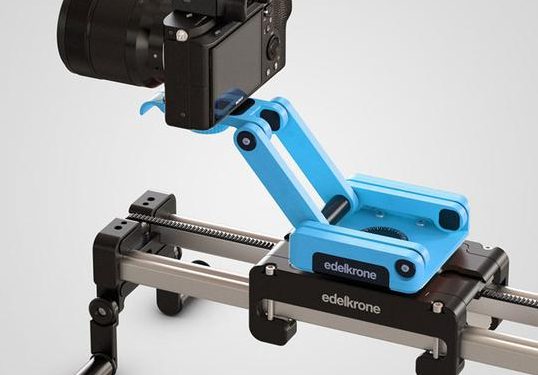When shooting video, an easy way to get buttery smooth panning and tracking is to use a mechanical device like a rail to literally slide the camera side to side. These range from what is essentially a skateboard to incredible programmable multi-axis industrial robots, a wide variety of which have been visible in the backgrounds of Youtuber’s sets for years. But even the “low end” devices can run hundreds of dollars (all that anodized aluminum doesn’t come cheap!). Edelkrone has been building lust worthy professional (read, pricey) motion setups for a decade. But in the last year they’ve started something pretty unusual; lowering prices with their Ortak series of 3D printed equipment. But this time, you do the printing.

Since the RepRap we’ve been excited about the future of democratized at home manufacturing, but to a large extent that dream hasn’t materialized. Printers are much more useful now than in the early days but you can’t buy a new mug from Starbucks and print it at home. But maybe that’s changing with Edelkrone’s offering.
When you buy an Ortak product you get one thing: all the fasteners and hardware. So the final product is more durable and appears more finished than what would pop out of your Prusa unaided. What about the rest of the device? That’s free. Seriously. Edelkrone freely provides STLs (including print setting recommendations) with detailed step-by-step assembly instructions and videos (sample after the break). Nice hack to avoid piracy, isn’t it?
Why choose the do-it-at-home style product? A significant price reduction of course! The Ortak line currently includes two products, the FlexTILT head you see above, and a skateboard-style slide called the SKATER 3D. Both of these were sold fully finished before making it to the DIY scene. The FlexTILT Head 2 comes in at $149 when you buy it whole. And when the PocketSKATER 2 was for sale, it included a FlexTILT Head and came to $249. Now? Each hardware kit is just $29.
So is this it? Have we hit the artisanal DIY micro-manufactured utopian dream? Not yet, but maybe we’re a little closer. Edelkrone is a real company which is really selling these as products, right there on their website along with everything else. They refer to it as “co-manufacturing” which we think is a clever name, and talk about expanding the program to include electronics. We can’t wait to see how the experiment goes!















You basically don’t pay for most expensive part – Labour.
There is just no way that 3d printed part will be cheaper than injection molded.
You pay pennies at home for it and you don’t think it will be cheaper? Maybe not if you’re buying the plastic but you’re daft if you don’t think printing it at home is cheaper.
Ah yes, but they are also avoiding the tooling costs for injection molding. Generally you have to sell about 10,000 units before you even start to make a profit.
And you don’t have to care about warranty for the printed parts.
They’re also selling what they’re good at — making smooth joints — and letting you customize the rest, which I think is cool.
But see Thomas Sanladerer’s video on the thing: https://www.youtube.com/watch?v=lhQ6IJM3SyA
Angus did a video on it too: https://www.youtube.com/watch?v=5BPSYyph7To
Actually, the OTC for tooling (not soft molds but the real thing) is just incredible. And if you go cheap you could end up with unusable out of tolerance parts and a suppler who still wants to be paid. Injection molded parts only get cheap if you can spread the OTC over a huge quantity of usable parts.
BTW They sell the equivalent in metal fully assembly without anything to do from the user.
If I do remember (see Linus Söderlind comment for reviews!) they took the time to actually made it 3d printable friendly. They didn’t just fix their STL to be 3d printable.
Maker’s Muse test: https://www.youtube.com/watch?v=5BPSYyph7To
Thomas Sanladerer test: https://www.youtube.com/watch?v=lhQ6IJM3SyA
A cool concept, and it will probably become common. Except all the printable parts will get printed, doubt many will buy a kit of screws. I could see a kit with motors and electronics, various metal parts, bearings. A printed part might wear or break quicker, but it would be simple and cheap just to print a replacement, maybe design a better replacement…
That is a slick concept and I would gladly pay $29 for a dolly like that when all I have to do is print some parts.